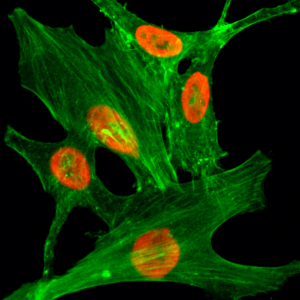
Immunocytochemical staining of HeLa cells treated with sodium butyrate, using anti-Acetyl-Histone H2A.Z (Lys4) Rabbit Monoclonal Antibody (clone RM221) (red). Actin filaments have been labeled with fluorescein phalloidin (green).
anti-Acetyl-Histone H2A.Z (Lys4), Rabbit Monoclonal (RM221)

REV-31-1101-00
ApplicationsWestern Blot, ELISA, ImmunoCytoChemistry, Other Application
Product group Antibodies
ReactivityVertebrate
TargetH2AZ1
Overview
- SupplierRevMAb Biosciences
- Product Nameanti-Acetyl-Histone H2A.Z (Lys4), Rabbit Monoclonal (RM221)
- Delivery Days Customer5
- ApplicationsWestern Blot, ELISA, ImmunoCytoChemistry, Other Application
- CertificationResearch Use Only
- ClonalityMonoclonal
- Clone IDRM221
- Concentration1 mg/ml
- Gene ID3015
- Target nameH2AZ1
- Target descriptionH2A.Z variant histone 1
- Target synonymsH2A histone family member Z; H2A.z; H2A.Z-1; H2A/z; H2AFZ; H2AZ; H2AZ histone; histone H2A.Z
- HostRabbit
- IsotypeIgG
- Scientific DescriptionHistones are proteins that package DNA into nucleosomes. Histones are responsible for maintaining the shape and structure of a nucleosome. One chromatin molecule is composed of at least one of each core histones per 100 base pairs of DNA. There are five families of histones known to date; these histones are termed H1/H5, H2A, H2B, H3, and H4. H2A is considered a core histone, along with H2B, H3 and H4. Core formation first occurs through the interaction of two H2A molecules. Then, H2A forms a dimer with H2B; the core molecule is complete when H3-H4 also attaches to form a tetramer. Histone H2A is composed of non-allelic variants, including H2A.1, H2A.2, H2A.X, and H2A.Z. H2A packages DNA molecules into chromatin and has been correlated with DNA modification and epigenetics. H2A plays a major role in determining the overall structure of chromatin and regulates gene expression. Protein modification on histone H2A exist and can sometimes result in a change in function. Different H2A variants were exploited to have different functions, genetic sequences and modifications. - Recombinant Antibody. This antibody reacts to Histone H2A.Z acetylated at Lysine 4 (K4ac). No cross reactivity with non-modified Lysine 4 or other acetylated Lysines in histone H2A. Applications: WB, ELISA, Multiplex, ICC. Source: Rabbit. Liquid. 50% Glycerol/PBS with 1% BSA and 0.09% sodium azide. Histones are proteins that package DNA into nucleosomes. Histones are responsible for maintaining the shape and structure of a nucleosome. One chromatin molecule is composed of at least one of each core histones per 100 base pairs of DNA. There are five families of histones known to date; these histones are termed H1/H5, H2A, H2B, H3, and H4. H2A is considered a core histone, along with H2B, H3 and H4. Core formation first occurs through the interaction of two H2A molecules. Then, H2A forms a dimer with H2B; the core molecule is complete when H3-H4 also attaches to form a tetramer. Histone H2A is composed of non-allelic variants, including H2A.1, H2A.2, H2A.X, and H2A.Z. H2A packages DNA molecules into chromatin and has been correlated with DNA modification and epigenetics. H2A plays a major role in determining the overall structure of chromatin and regulates gene expression. Protein modification on histone H2A exist and can sometimes result in a change in function. Different H2A variants were exploited to have different functions, genetic sequences and modifications.
- ReactivityVertebrate
- Storage Instruction-20°C
- UNSPSC12352203
